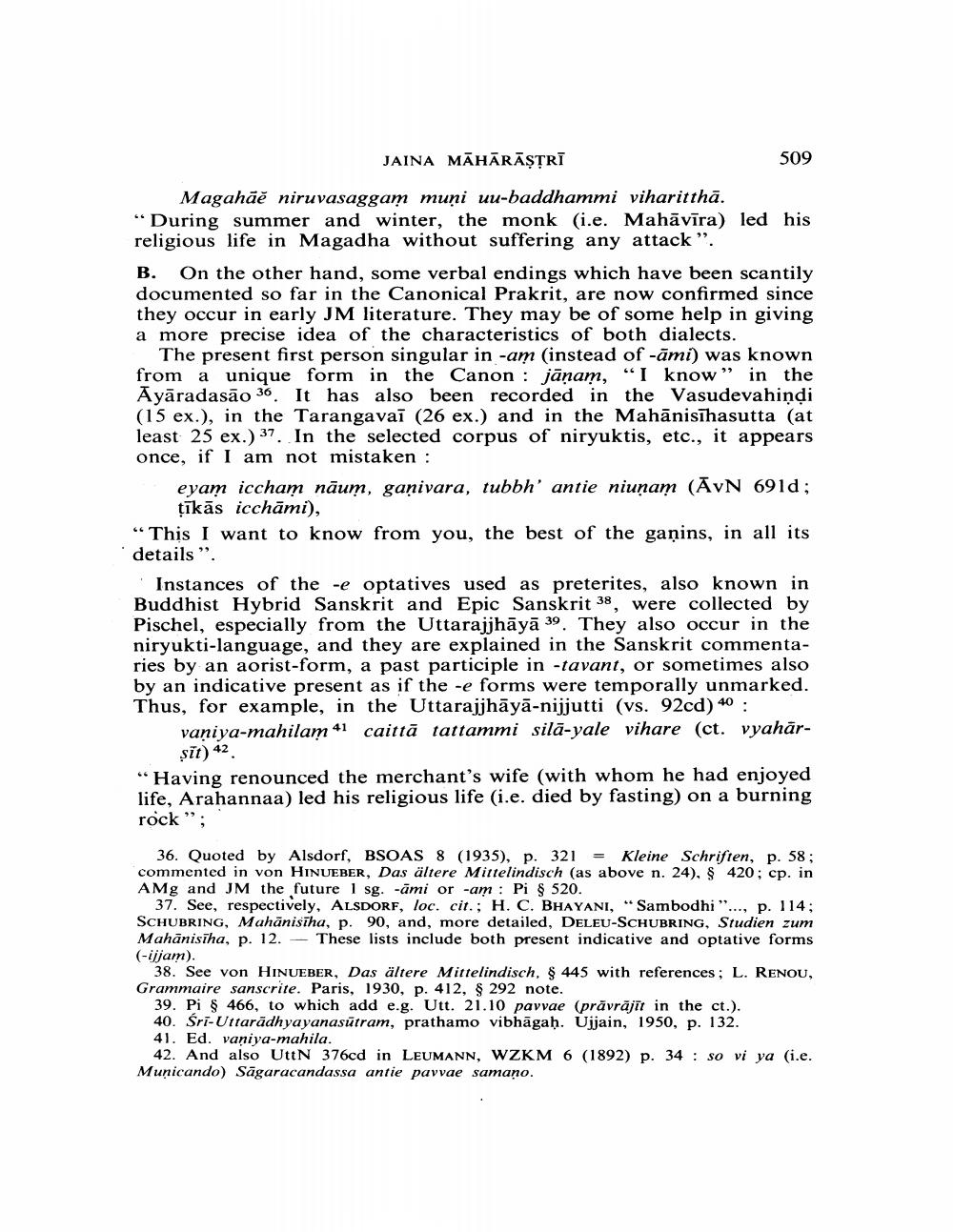Book Title: Morphological Evidence For Dialectal Variety In Jaina Maharastri Author(s): Nalini Balbir Publisher: Nalini Balbir View full book textPage 7
________________ JAINA MĀHĀRĀȘTRĪ 509 Magahāě niruvasaggam muņi uu-baddhammi viharitthā. “During summer and winter, the monk (i.e. Mahāvīra) led his religious life in Magadha without suffering any attack". B. On the other hand, some verbal endings which have been scantily documented so far in the Canonical Prakrit, are now confirmed since they occur in early JM literature. They may be of some help in giving a more precise idea of the characteristics of both dialects. The present first person singular in -am instead of -āmi) was known from a unique form in the Canon : jānam, “I know” in the Ayāradasāo 36. It has also been recorded in the Vasudevahindi (15 ex.), in the Tarangavai (26 ex.) and in the Mahānisīhasutta (at least 25 ex.) 37. In the selected corpus of niryuktis, etc., it appears once, if I am not mistaken : eyam iccham nāum, ganivara, tubbh' antie niunam (AvN 6910; tīkās icchāmi), “This I want to know from you, the best of the gaņins, in all its details". Instances of the -e optatives used as preterites, also known in Buddhist Hybrid Sanskrit and Epic Sanskrit 38, were collected by Pischel, especially from the Uttarajjhāyā 39. They also occur in the niryukti-language, and they are explained in the Sanskrit commentaries by an aorist-form, a past participle in -tavant, or sometimes also by an indicative present as if the -e forms were temporally unmarked. Thus, for example, in the Uttarajjhāyā-nijjutti (vs. 92cd) 40 : vaniya-mahilam 41 caittā tattammi silā-yale vihare (ct. vyahār șit) 42 “Having renounced the merchant's wife (with whom he had enjoyed life, Arahannaa) led his religious life (i.e. died by fasting) on a burning rock"; 36. Quoted by Alsdorf, BSOAS 8 (1935), p. 321 = Kleine Schriften, p. 58: commented in von HINUEBER, Das ältere Mittelindisch (as above n. 24), § 420; cp. in AMg and JM the future 1 sg. -āmi or -am : Pi § 520. 37. See, respectively, ALSDORF, loc. cit.; H. C. BHAYANI, “Sambodhi"..., p. 114; SCHUBRING, Mahānisiha, p. 90, and, more detailed, DELEU-SCHUBRING, Studien zum Mahānisiha, p. 12. — These lists include both present indicative and optative forms (-ijjam). 38. See von HINUEBER, Das ältere Mittelindisch, $ 445 with references; L. RENOU, Grammaire sanscrite. Paris, 1930, p. 412, $ 292 note. 39. Pi $ 466, to which add e.g. Utt. 21.10 pavvae (prăvrăjit in the ct.). 40. Sri-Uttaradhyayanasūtram, prathamo vibhāgah. Ujjain, 1950, p. 132. 41. Ed. vaniya-mahila. 42. And also Uttn 376cd in LEUMANN, WZKM 6 (1892) p. 34 : so vi ya (i.e. Municando) Sāgaracandassa antie pavvae samano.Page Navigation
1 ... 5 6 7 8 9 10 11 12 13 14 15 16 17 18 19 20 21 22 23
